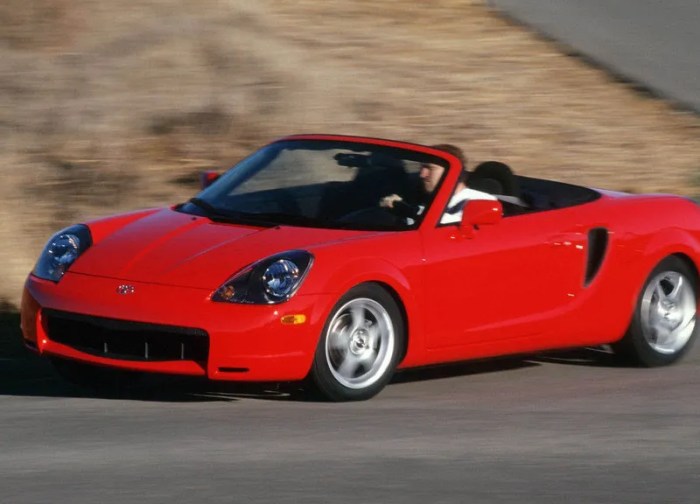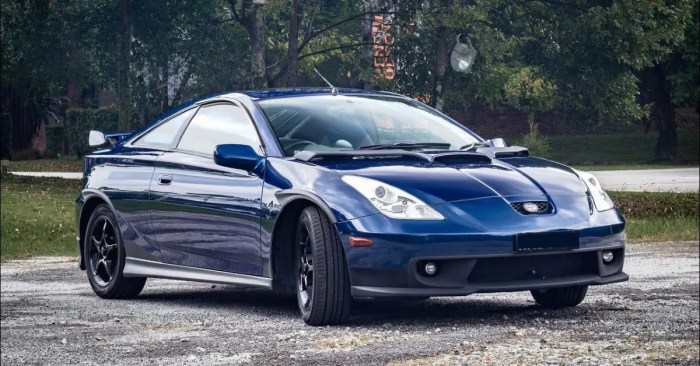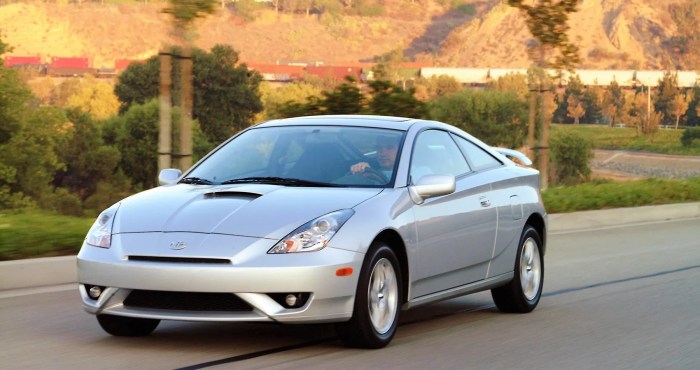Toyota Sports Cars 2000s: This era saw a fascinating blend of Japanese engineering prowess and evolving design philosophies. From the iconic Celica’s final run to the quirky yet beloved MR2, this period showcased Toyota’s attempts to carve a niche in the competitive sports car market.
We’ll explore the models, their technological advancements, performance characteristics, and lasting cultural impact, revealing a story of innovation and evolution.
We’ll delve into the specific models produced during this decade, examining their engine technologies, safety features, and overall driving experiences. We’ll also look at how these cars were received by critics and the public, and how they’ve become ingrained in popular culture.
Get ready for a nostalgic journey through a significant chapter in Toyota’s automotive history.
Popular Toyota Sports Cars of the 2000s

The 2000s saw Toyota expand its sports car lineup, offering a range of models appealing to different tastes and budgets. While not always the most powerful or extreme, these cars offered a blend of affordability, reliability, and engaging driving dynamics, carving out a niche for themselves in a competitive market.
This section details some of the most memorable models from this era.
Toyota Sports Car Models of the 2000s
The following table summarizes key specifications for several popular Toyota sports cars produced during the 2000s. Note that production years may vary slightly depending on the specific market.
| Model | Year | Engine Specs | Notable Features |
|---|---|---|---|
| Toyota Celica | 1999-2006 | 1.8L I4, 2.0L I4 (various power outputs depending on year and trim) | Sharp handling, sporty styling (especially the later generation), available all-wheel drive (AWD) in some markets. |
| Toyota MR2 Spyder | 2000-2005 | 1.8L I4 | Mid-engine layout, lightweight design, roadster body style, nimble handling. |
| Toyota Corolla XRS | 2005-2008 | 1.8L I4 | Sport-tuned suspension, more aggressive styling than standard Corolla, affordable entry into sporty driving. |
Toyota Supra (A80
|
1993-2002 | 3.0L I6 Twin Turbo | Iconic status, powerful engine, legendary handling and performance. While production technically ended in the mid-90s, sales and parts availability continued into the early 2000s. |
| Toyota Altezza (Lexus IS in some markets) | 1998-2005 | 2.0L I4, 3.0L V6 | Sporty sedan with rear-wheel drive (RWD), sharp styling, a precursor to the Lexus IS series. |
Design Philosophy and Target Audience
Each model targeted a specific segment of the sports car market. The Celica aimed for a balance of practicality and sporty appeal, attracting a younger, more budget-conscious driver.
The MR2 Spyder, with its mid-engine layout and roadster design, catered to enthusiasts seeking a lightweight, agile driving experience. The Corolla XRS offered a more accessible entry point to sporty driving for those who wanted a performance upgrade within the practicality of a Corolla.
The Supra’s legacy continued to attract a dedicated following of performance enthusiasts, while the Altezza/Lexus IS provided a sportier sedan alternative. These cars, while varying in performance and price, shared a common thread: delivering an enjoyable and engaging driving experience within the Toyota framework of reliability and affordability.
Technological Advancements in Toyota Sports Cars (2000s): Toyota Sports Cars 2000s

The 2000s marked a period of significant technological leaps for Toyota’s sports car lineup. These advancements weren’t just about boosting horsepower; they focused on integrating innovative engine technology, refined transmission systems, and enhanced safety features to deliver a more engaging and secure driving experience.
This period saw a shift towards more sophisticated engineering, resulting in cars that were both faster and safer than their predecessors.Toyota’s sports car engine technology in the 2000s saw considerable refinement. This involved not only increasing power outputs but also improving fuel efficiency and reducing emissions.
Several key innovations were employed across different models, showcasing Toyota’s commitment to pushing the boundaries of performance and efficiency.
Engine Technology Advancements
Toyota leveraged advancements in variable valve timing (VVT-i) technology throughout its sports car range during the 2000s. VVT-i allowed for more precise control over engine valve timing, optimizing performance across the rev range. This resulted in improved horsepower and torque, along with better fuel economy compared to earlier, less sophisticated systems.
The Celica GT-S, for example, utilized a refined VVT-i system on its 1.8L engine, delivering a noticeable improvement in responsiveness and power delivery compared to previous generations. Furthermore, some models, like the later generation MR2 Spyder, saw the implementation of supercharging or turbocharging to boost power output, demonstrating Toyota’s exploration of different performance enhancing strategies.
The differences between naturally aspirated engines with VVT-i and those with forced induction were significant, with supercharged or turbocharged engines offering substantially more power and torque, albeit often at the cost of slightly reduced fuel efficiency.
Transmission System Improvements
The 2000s also saw improvements in transmission technology within Toyota’s sports cars. The shift towards closer-ratio gearboxes in models like the Celica and the MR2 Spyder enhanced acceleration and responsiveness. These transmissions allowed drivers to keep the engine within its optimal power band more easily, leading to quicker acceleration times.
Furthermore, the introduction of more advanced automatic transmissions, including those with electronically controlled shifting, provided a smoother and more efficient driving experience. These automatic gearboxes often offered manual shift modes, allowing drivers to retain some level of control over gear changes while enjoying the convenience of automatic shifting.
The differences between the manual and automatic transmissions were largely in driver preference and driving style, with manuals offering more driver engagement while automatics provided greater ease of use.
Safety Feature Enhancements
Safety was a key area of focus for Toyota in the 2000s. Their sports cars started to incorporate more advanced safety systems, moving beyond basic airbag deployments. The adoption of electronic stability control (ESC) became more widespread, helping to prevent loss of control during challenging driving conditions.
ESC works by monitoring wheel speed and steering input, and intervening with braking and engine power to maintain stability. Furthermore, Toyota improved airbag technology, introducing side airbags and side curtain airbags in several models, enhancing protection for occupants in side impacts.
These advancements were a significant step forward in passenger safety, demonstrating Toyota’s commitment to building safer sports cars. The implementation of these features was a significant upgrade from earlier models, which often only had driver and passenger airbags as standard.
Performance and Handling Characteristics
The Toyota sports cars of the 2000s offered a diverse range of performance and handling capabilities, catering to different driver preferences and skill levels. While not always competing directly with European sports car giants in terms of outright power, they often impressed with their balanced chassis and engaging driving dynamics.
This section will delve into the specifics of several key models, comparing their performance metrics and analyzing the engineering choices that shaped their on-road behavior.
Performance Metrics Comparison
The following table summarizes the 0-60 mph acceleration times, top speeds, and horsepower figures for some notable Toyota sports cars from the 2000s. These figures represent manufacturer claims or widely accepted test results and may vary slightly depending on testing conditions and vehicle specifications.
| Model | 0-60 mph (seconds) | Top Speed (mph) | Horsepower |
|---|---|---|---|
| Toyota Celica GT-S (2000-2005) | 7.0-7.5 | 130-135 | 180 |
| Toyota MR2 Spyder (2003-2005) | 7.5-8.0 | 130-135 | 140 |
| Toyota Supra (1998-2002) | 4.5-5.0 | 155 (Electronic Governor) | 320 |
| Toyota Celica GT-S (ZZT231) (2000-2005) | 7.0-7.5 | 130-135 | 180 |
Note that the Supra’s figures are significantly higher due to its larger engine displacement and turbocharging. The Celica and MR2 Spyder represent more attainable and comparatively less powerful options. The figures provided are approximate ranges, as minor variations exist based on specific model year and optional equipment.
Handling Characteristics and Contributing Factors
The handling characteristics of these Toyota sports cars were largely determined by their suspension designs and weight distribution. The MR2 Spyder, with its mid-engine layout, boasted exceptional handling balance and agility, exhibiting minimal body roll and predictable responses to steering inputs.
Its lightweight construction further enhanced its responsiveness. The Celica, on the other hand, utilized a front-engine, front-wheel-drive configuration, which while less inherently balanced than the MR2, benefited from a relatively sophisticated suspension system for its class, delivering competent handling.
The Supra, a heavier car with a front-engine, rear-wheel-drive layout, provided a different driving experience; its powerful engine required a more robust chassis and suspension to manage its torque. Its weight distribution, while favoring the front, was still carefully managed to deliver controlled handling.
Comparative Analysis of Handling and Performance
The following chart summarizes the strengths and weaknesses of each model’s handling and performance.
| Model | Performance Strengths | Performance Weaknesses | Handling Strengths | Handling Weaknesses |
|---|---|---|---|---|
| Toyota Celica GT-S | Relatively quick acceleration for its class, good fuel economy | Lower horsepower compared to Supra | Good grip and predictable handling, comfortable ride | Front-wheel drive can experience torque steer under hard acceleration |
| Toyota MR2 Spyder | Lightweight and agile, good fuel efficiency | Lower horsepower and torque compared to others | Exceptional handling balance, minimal body roll, precise steering | Limited practicality due to small size and two-seater configuration |
| Toyota Supra | Exceptional acceleration and top speed, high horsepower | Higher fuel consumption, less fuel efficient than Celica and MR2 | Powerful engine, capable of handling high speeds, strong braking system | Heavier weight compared to others, requires a more skilled driver to manage its power |
Cultural Impact and Reception

Toyota’s foray into the sports car market during the 2000s, while not as dominant as its presence in other segments, left a noticeable mark on automotive culture. These cars, often positioned as affordable performance options, carved a niche for themselves, attracting a different demographic than the established sports car giants.
Their impact extended beyond sales figures, influencing perceptions of Japanese automotive engineering and shaping the landscape of affordable enthusiast driving.The critical reception of Toyota’s 2000s sports cars was generally positive, though often nuanced. Publications like
- Motor Trend*,
- Car and Driver*, and
- Road & Track* consistently praised aspects like reliability, affordability, and surprisingly engaging handling. However, reviews frequently noted a lack of outright performance compared to European rivals, and some criticized the styling as somewhat conservative. The overall consensus was that these Toyotas offered excellent value and a fun driving experience, but fell short of being class-leading in terms of raw power or cutting-edge technology.
Automotive Publication Reviews
Major automotive publications generally lauded the value proposition of Toyota’s sports cars. Reviews often highlighted the balance between performance and practicality, emphasizing their reliability and relatively low price points. While not always praised for breathtaking speed or exotic features, these vehicles frequently earned accolades for their surprisingly competent handling and overall driving experience.
For example, the Celica GT-S frequently received positive comments for its nimble chassis and responsive engine, while the MR2 Spyder was often lauded for its lightweight design and engaging driving dynamics. Negative critiques often centered on a perceived lack of raw power or a less-than-exciting design compared to competitors.
Cultural Impact in Popular Media
Toyota’s 2000s sports cars, while not achieving the iconic status of some European or American counterparts, still found their way into popular culture. While not featured as prominently as, say, a Porsche 911 or a Ford Mustang, models like the Celica and MR2 occasionally appeared in films, television shows, and video games, often representing a reliable and sporty option for everyday drivers or characters with a less extravagant lifestyle.
Their presence, though subtle, helped solidify their place in the broader automotive consciousness. The cars’ affordability and practicality likely contributed to their use in scenes depicting more relatable characters and situations.
Marketing Strategies
Toyota’s marketing strategies for its 2000s sports cars focused on highlighting their value proposition: performance and reliability at a competitive price. Advertisements often emphasized the cars’ handling characteristics and fuel efficiency, appealing to a younger, budget-conscious demographic. Unlike the aggressive, image-focused marketing campaigns of some competitors, Toyota’s approach was more understated, emphasizing practicality and long-term value.
This strategy reflected Toyota’s overall brand image at the time, associating its sports cars with dependability and sensible performance, rather than purely exhilarating speed or luxury. The marketing often showcased the cars in everyday settings, further emphasizing their practicality and affordability.
Illustrative Examples
The Toyota Celica and MR2 represent compelling case studies in the evolution of Toyota’s sports car offerings during the 2000s. Both models, while sharing a sporty heritage, catered to distinct driver preferences and market segments, reflecting Toyota’s diverse approach to the sports car market.
Their design philosophies and performance characteristics offer valuable insights into the trends and innovations of the era.
Toyota Celica (2000-2005)
The seventh-generation Celica, produced from 2000 to 2005, marked a significant departure from its predecessors. It transitioned away from the wedge-shaped design that had characterized earlier models, adopting a more rounded and aerodynamic profile. This generation notably shifted away from the liftback styling of previous generations and towards a more conventional coupe design.
Performance-wise, it offered a range of engines, with the higher trims boasting respectable power output for its class. The focus shifted towards a more refined and comfortable driving experience compared to its sharper-handling predecessors, appealing to a broader audience.Image Description: The 2000-2005 Celica’s image would show a sleek, curvy coupe silhouette.
Key design elements include the smooth, flowing lines, the rounded headlights integrated into the fenders, and a relatively low, wide stance. The rear features taillights that wrap around the sides, adding to its aerodynamic appearance. The overall impression is one of modern elegance and sophisticated sportiness rather than aggressive performance.
Toyota MR2 Spyder (2000-2005), Toyota sports cars 2000s
The second generation of the MR2 Spyder (WW20), available from 2000 to 2005, represented a departure from the previous generation’s turbocharged performance. It emphasized a lightweight design and agile handling, providing a more engaging driving experience for enthusiasts. The Spyder was a two-seater roadster, offering an open-top driving experience.
Its mid-engine layout, a hallmark of the MR2 lineage, contributed to exceptional balance and handling. While not exceptionally powerful, the engine provided adequate performance coupled with exceptional fuel efficiency.Image Description: The MR2 Spyder’s image would showcase its low-slung roadster profile with its distinctive pop-up headlights, a feature that contributed to its retro-modern aesthetic.
The soft-top convertible roof is clearly visible, emphasizing the open-air driving experience. The car’s compact size and wide track are apparent, hinting at its nimble handling characteristics. The overall design is a blend of classic roadster aesthetics and modern Toyota styling cues.
Comparison of the Celica and MR2
The Celica and MR2, while both Toyota sports cars of the 2000s, targeted distinct customer segments. The Celica, with its more conventional coupe body style and refined driving experience, appealed to a wider range of buyers seeking a stylish and comfortable sports car.
The MR2 Spyder, with its mid-engine layout, roadster design, and focus on handling, attracted a more specialized audience of driving enthusiasts prioritizing a pure, engaging driving experience. While both offered sporty performance, the Celica prioritized comfort and everyday usability, while the MR2 Spyder prioritized agility and driving pleasure.
In terms of design, the Celica embraced a more contemporary, rounded aesthetic, whereas the MR2 Spyder retained a more classic roadster feel with a touch of modern flair.
Concluding Remarks
The Toyota sports cars of the 2000s, while perhaps not as universally celebrated as some European counterparts, represent a notable period in the brand’s history. They showcased advancements in technology and design, reflecting the changing landscape of the sports car market.
Their unique blend of performance, reliability, and affordability cemented their place in the hearts of many enthusiasts and left a lasting legacy in automotive culture. Ultimately, they offer a compelling case study in the evolution of a brand striving for global automotive prominence.
FAQ
Were any Toyota sports cars from the 2000s offered with manual transmissions?
Yes, many models offered manual transmissions as an option, though automatics became increasingly common.
How did the reliability of these Toyota sports cars compare to other brands?
Toyota maintained its reputation for reliability, generally receiving positive marks for longevity and low maintenance needs.
Did any of these cars achieve significant motorsport success?
While not dominant in major championships, some models saw success in regional racing series and amateur events.